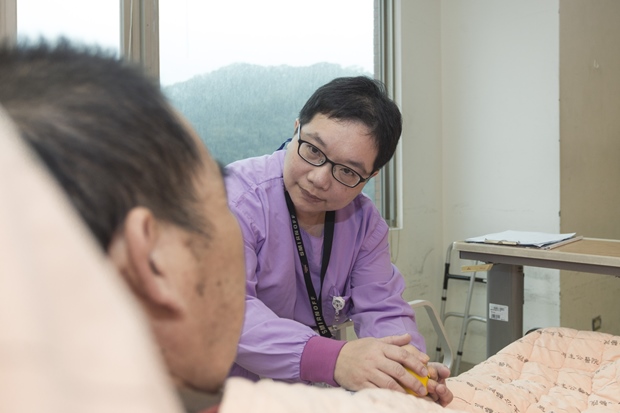Total Care Nursing Saves Families Time, Money

Source:Justin Wu
Some 60% of hospitalized patients in Taiwan rely on relatives for day-to-day care. Now a group in Sanxia is trying to ease the burden on patients’ families tasked with caring for sick loved ones.
Views
Total Care Nursing Saves Families Time, Money
By Yi-ting LinFrom CommonWealth Magazine (vol. 643 )
“Seriously, NT$2,400 per day for hospital care is so expensive; it’s too much to bear,” laments Lin Yu-hsien. When Lin’s brother-in-law was hospitalized for a month, had the family hired one-on-one personal care, it would have cost them between NT$60,000 and 70,000.
Given the unbearable economic burden of hospital care, the entire family pitched in at the hospital, caring for Lin’s brother-in-law in shifts. But this did not sit well with Lin, who relates, “Having to shuttle back and forth to the hospital was truly mentally and physically exhausting for my elderly in-laws.” Sometimes, after work or on weekends and holidays, she had to rush straight to the hospital for her shift, never getting even a moment’s rest. For some family members, the hospital became like a second home, and when they got sleepy at night they would grab a chair and fall asleep sitting up.
Taiwan’s national healthcare system is sometimes called the best in the world, yet “when one person is hospitalized, the whole family falls apart” is not an uncommon occurrence. Such situations affect the family members’ work and put a huge strain on their finances.
A survey conducted by the Taiwan Association of Family Caregivers in 2017 found that 60 percent of Taiwanese patients hospitalized due to illness were accompanied by a single family member or alternately by multiple family members at all times; 25 percent of families, urgently needing assistance, hired daytime or around-the-clock one-on-one care, spending an average of NT$2,960 per day for hospital care services.
“The government and hospitals pass patient care off on family members to save money,” laments Chou Chaw-Fang, Adjunct Associate Professor at National Taiwan University’s Department of Nursing. The 74-year-old Chou, who sports short curly hair, looks like the grandmother next door, but when the conversation turns to healthcare reform in Taiwan, she becomes a powerful dynamo. A veteran of over 50 years in nursing, Chou has previously served as head of the nursing division at NTU Hospital, and Assistant Administrator of the En Chu Kong Hospital (恩主公醫院) in Sanxia.
Chou frequently encounters people forced to stretch the elastic of family life and work in order to take care of sick family members. Lacking professional training, they are often confused about how to care for the patient, sometimes to the extent that their lack of knowledge and experience only exacerbates the patient’s illness when they try to help with such tasks as repositioning in bed or feeding.
In recent years, she has observed a growing number of elderly people administering the caregiving, and even seen one person at the hospital to accompany a sick relative have a heart attack right there in the patient’s room, succumbing before the patient did.
Too many tragedies have unfolded before her to stomach. “Why is it the family members who have to suffer?” she wonders aloud.
This issue continues to motivate Chou to this day, as she busily moves between government agencies, hospitals, and advocating on different media programs for the full-scale adoption of a total care nursing system like that practiced in Europe and North America. Under such systems, specialized nursing aides and registered nurses (RNs) care for patients in tandem, taking up some of the family’s slack. Nursing aides are typically responsible for patient feeding and hygiene, while nurses take care of such tasks as giving injections and clearing phlegm.
Total Care Reshaping Taiwan’s Stay-along Patient Care Culture
Chou does more than talk the talk; she puts her philosophy into practice. She planted the first seeds in Sanxia 20 years ago, training 40 nursing aides to slowly turn the tide on Taiwan’s “stay-along patient care” culture.
The opportunity arose at the intersection of the 56-year-old Chou’s retirement from NTU Hospital’s nursing department and preparations for the new En Chu Kong Hospital. The new hospital presented an ideal platform for Chou to put her desire to experiment and institute healthcare reform into practice. In short order, she recruited and trained several dozen local Sanxia women, mostly from rural backgrounds or those taking on a second career, as nursing aides. En Chu Kong Hospital became the first hospital in Taiwan to institute a total care system, which remains in place to this day.
Seven years ago, Lin Yu-hsien, who had personally endured the frustrations of a family accompanying a sick member at the hospital, went from full-time housewife delivering boxed lunches part time to a full-fledged member of En Chu Kong Hospital’s nursing care team. For the past three years, she has been a member of the hospital’s new Total Care Nursing Room.
Each morning at eight o’clock when their shift begins, she and her team members set about helping patients with turning over in bed, eating, and washing, eliminating the need for family members to be present around the clock. She and the members of the team, dressed in purple uniforms, have been described as “purple angels” by grateful family members.
Although their jobs appear to be no different from that of personal one-on-one care hired by a patient’s family, they are actually in-house nursing assistants employed by the hospital, not contracted like most personal caregivers in hospitals.
Chan Pi-tuan, director of the Department of Nursing at En Chu Kong Hospital, enumerates the differences.
First, quality of care can vary widely from contractor to contractor, and often a new caregiver is assigned after just a few days. The family also has no say in whom the agency assigns, so they can only hope for the best. Sometimes, when the caregiver’s approach is incorrect or inappropriate, the nursing staff can do nothing about it.
In contrast, in-house nursing aides come under the direct management of the head nurse, making the quality of care quite stable. For instance, Lin Yu-hsien is on duty for regular 12-hour shifts in the hospital’s Total Care Room, where she strictly follows caregiving protocols (such as repositioning the patient every two hours, and washing the patient’s hair every three days) to provide more standardized, professional care.
Further, compared to one-on-one hospital care, Lin cares for a maximum of four patients on a rotating daytime shift basis. In Taiwan, where there is a shortage of caregiver manpower, this type of “shared manpower” is a better use of resources. Not only that, but it lightens the economic load on family members by half, costing them a maximum of NT$1,200 out of pocket.
 In-house hospital nursing aide staff help patients reposition in bed, eat, and wash so family members no longer need to be present at all times. (Image: Justin Wu)
In-house hospital nursing aide staff help patients reposition in bed, eat, and wash so family members no longer need to be present at all times. (Image: Justin Wu)
Less Grueling, More Professional Caregiving
This approach has improved healthcare quality and made nursing less of a grueling form of labor. For instance, some patients need to be washed or bathed three times per week to prevent recurrent infections. However, in the past, registered nurses were like whirling dervishes at work, personally responsible for taking care of a dozen or more patients at a time. “It makes you wish you had three heads and six arms; you’re so busy there’s no way to do a proper job,” admits head nurse Chiu Yu-fen.
Fortunately, the hospital’s introduction of nursing assistants has improved the situation. In 2015, the En Chu Kong Hospital’s Total Care Room’s infection rate was 0.5 percent, significantly lower than the 1.5 percent overall average infection rate among regional hospitals throughout Taiwan.
“All I ask is that my patients to be discharged safely from the hospital,” says Lin, for whom her work is a socially meaningful job that never gets too tiring for her. With the hospital’s backing, she has a stable income and can keep taking various training courses the hospital offers.
“I’m delighted as long as family members say ‘you’ve improved.’ I never even thought I’d be able to do this sort of work before,” she adds. The stability and feelings of accomplishment have helped keep her there for seven years now. And she is not alone in her seniority, as 60 percent of nursing aides have worked at the hospital for more than five years. This goes completely against established industry precedent, where nursing aide retention is universally low.
The power of this revolution in caregiving culture is continuing to spread and take root.
The lessons of the 2003 SARS epidemic, under which patients’ family members and nursing staff infected each other, continue to reverberate today as Taiwan’s stay-along hospital care culture caused leaks in the infection control system. From 2006, the government began instituting total nursing care on a trial basis at 14 hospitals around Taiwan, prompting other hospitals including Cardinal Tien Hospital in Xindian, Show Chwan Memorial Hospital in Changhwa, and Hualien’s Mennonite Christian Hospital to follow suit prompted by the support of their respective directors. And this year, the Ministry of Health and Welfare has begun promoting a Hospitalization-friendly Hospitals program.
 En Chu Kong Hospital nursing aide, Lin Yu-hsien, sees helping families and registered nurses with caregiving duties as a socially meaningful mission as well as a good profession. (Image: Justin Wu)
En Chu Kong Hospital nursing aide, Lin Yu-hsien, sees helping families and registered nurses with caregiving duties as a socially meaningful mission as well as a good profession. (Image: Justin Wu)
Money the Biggest Obstacle
Still, funding is still invariably the biggest issue. “Caregiving has inherent costs,” admits Chan Pi-tuan. “It (the nursing department) costs money. Manpower costs are high, and so is our stress level.” Elaborating, Chan notes that it costs over NT$12 million to employ a team of 40 nursing aides each year, a significant manpower expenditure that gives some hospitals interested in following suit pause. “Many hospitals that make visits to our hospital have the right ideas and the capacity to carry it out, but money remains the biggest obstacle,” she notes.
As Chou Chaw-Fang explains, National Health Insurance and government policy support, as well as the enthusiastic backing of hospital executives, are all critical for total care nursing to take root and thrive across the hospital system in Taiwan. The public must also be willing to bear some of the cost burden, as any good system can never be free or cheap.
“One day, Taiwan’s patients and their family members will no longer have to suffer due to hospitalization, and the professionalism and quality of hospital care can be improved,” says Chou hopefully.
Translated from the Chinese article by David Toman
Additional Reading
♦ The Home Care Medical Revolution
♦ No More ‘Kidney Dialysis Island’
♦ A Growing Class of ‘Down and Out Elderly’







